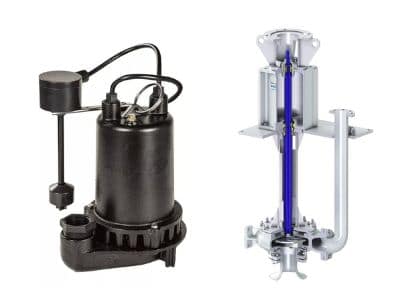What Is a Sump Pump?
A sump pump is a device that detects rising water levels around the lowest part of a home or basement, then diverts the water elsewhere. A sump pump motor can either be submerged in water or rest above-ground–it depends on the home’s needs.
If a home doesn’t have a sump pump, its basement can flood in a matter of minutes, and there is very little that homeowners can do to minimize the damage. Before it’s too late, one should consider the benefits of sump pump installation. Doing so could mean the difference between peace of mind and thousands of dollars in structural damage.
How Do Sump Pumps Work?

- Water accumulates in the area around the basement. This could happen during a rainstorm or when a sewer main backs up.
- The sump pump senses the water rising in a basin, and it turns on the sump pump.
- From there, the sump pump will divert water away from home. The water will go far enough away so that it won’t come back later or threaten the home’s structure.
Sump pumps are vital in places prone to heavy flooding and rainfall because sump pumps are the first line of defense against flooding.
There Are Two Main Types of Sump Pumps

- Submersible sump pumps: To install these devices, a plumber will first dig a basement pit, then place the submersible sump pump inside. The motor will be in the hole and can be submerged in water. Once the pit fills with water, it’ll turn on and divert the floodwater elsewhere. This type of sump pump is typically more efficient than the other but more expensive and has a shorter lifespan because the motor is submerged.
- Pedestal pumps: The motor on these devices does not go underwater. Instead, they’re either installed above or in very shallow pits. They make more noise because the motor isn’t muffled by being submerged. They’re generally cheaper to install and last longer than the other. However, they cannot withstand sediment buildup as well as submersible sump pumps can.
A plumber can assess one’s home and explain what sump pump would work best. They’ll consider the home’s location, square footage, and whether it has previously sustained water damage.
Benefits of a Having a Sump Pump
Protecting the basement from flooding is just one benefit of having a sump pump. Other benefits include:
- They prevent mold growth. When a home floods, mold and mildew growth are inevitable, and over time, these growths can cause illness, destroy drywall, and compromise a home’s habitability.
- They reduce property damage. Many homeowners use basements as in-home storage units, storing their bicycles, Christmas decorations, and other precious items. A sump pump can help prevent flood damage from destroying these items–some of which are impossible to replace. It also protects the home from water damage that can affect the structural integrity of a home.
Sump pumps can save homeowners time, money, and frustration in the long run.
About Vuksani Service Group
Vuksani Service Group provides the residents of New York, NY, professional services at competitive rates. They offer straightforward pricing, same-day service, on-time arrival, and 24/7 emergency repairs. Call them today for sump pump services in New York, NY.
Distribution Links +
- htv10.tv
- southeast.newschannelnebraska.com
- rivercountry.newschannelnebraska.com
- wicz.com
- rfdtv.com
- snntv.com
- central.newschannelnebraska.com
- metro.newschannelnebraska.com
- midplains.newschannelnebraska.com
- northeast.newschannelnebraska.com
- plattevalley.newschannelnebraska.com
- panhandle.newschannelnebraska.com
- wpgxfox28.com
- lifestyle.mykmlk.com
- wtnzfox43.com
- lifestyle.3wzfm.com
- lifestyle.southernsportstoday.com
- lifestyle.thepodcastpark.com
- lifestyle.680thefan.com
- lifestyle.xtra1063.com
- lifestyle.953hlf.com
- lifestyle.rewind1019.com
- lifestyle.us983.com
- lifestyle.countrylegends1059.com
- lifestyle.967wshv.com
- lifestyle.1045thedan.com
- yournewsnet.com
- michigan.yournewsnet.com
- midwest.yournewsnet.com
- northeast.yournewsnet.com
- southeast.yournewsnet.com
- southwest.yournewsnet.com
- lifestyle.earl983.com
- west.yournewsnet.com
- lifestyle.maverick1023.com
- lifestyle.magic979wtrg.com
- lifestyle.1077lakefm.com


















